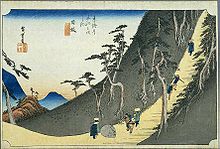Nissaka-shuku
- Nissaka-shuku
-
Nissaka-shuku (日坂宿, Nissaka-shuku?) était la vingt-cinquième des cinquante-trois stations du Tōkaidō de la route du Tōkaidō. Elle est située dans la ville actuelle de Kakegawa, dans la préfecture de Shizuoka, au Japon.
Histoire
En 1955, le village de Nissaka dans le district d'Ogasa s'est réuni à la ville voisine de Kakegawa.
Ekiden
La ville de Kakegawa accueille la course Nissaka-juku ekiden (日坂宿駕籠駅伝, Nissaka-juku ekiden?) en avril chaque année[1].
Stations voisines
- Tōkaidō
- Kanaya-juku - Nissaka-shuku - Kakegawa-juku
Bibliographie
- Carey, Patrick. Rediscovering the Old Tokaido:In the Footsteps of Hiroshige. Global Books UK (2000). ISBN 1901903109
- Chiba, Reiko. Hiroshige's Tokaido in Prints and Poetry. Tuttle. (1982) ISBN 0804802467
- Taganau, Jilly. The Tokaido Road: Travelling and Representation in Edo and Meiji Japan. RoutledgeCurzon (2004). ISBN 0415310911
Notes et références
Articles connexes
Wikimedia Foundation.
2010.
Contenu soumis à la licence CC-BY-SA. Source : Article Nissaka-shuku de Wikipédia en français (auteurs)
Regardez d'autres dictionnaires:
Nissaka-shuku — in the 1830s, as depicted by Hiroshige in The Fifty three Stations of the Tōkaidō Nissaka shuku (日坂宿, Nissaka shuku … Wikipedia
Ai no shuku — Les Ai no Shuku (間の宿, station intermédiare?) étaient des stations informelles le long des routes historiques du Japon. Ces stations se formaient naturellement sur les routes (telles que le Tōkaidō et le Nakasendō) quand la distance entre deux… … Wikipédia en Français
Ai no shuku — were unofficial post stations along historical routes in Japan. These post stations formed organically along routes (such as the Tōkaidō and the Nakasendō) when the distance between two places was too far or when there were difficult passes… … Wikipedia
Okazaki-shuku — Okazaki juku in the 1830s, as depicted by Hiroshige in the Hoeido edition of The Fifty three Stations of the Tōkaidō (1831 1834) Okazaki shuku (岡崎宿, Okazaki shuku … Wikipedia
Mishima-shuku — in the 1830s, as depicted by Hiroshige in the Hoeido edition of The Fifty three Stations of the Tōkaidō (1831 1834) Mishima shuku (三島宿, Mishima shuku … Wikipedia
Les Cinquante-trois Stations du Tōkaidō — Portrait de Hiroshige, le crâne rasé, à cinquante ans passés[N 1], par Kunisada. Les Cinquante trois Stations du Tōkaidō ( … Wikipédia en Français
Liste des stations du Tōkaidō — Le Tōkaidō en 1865. Les 53 Stations du Tōkaidō (東海道五十三次, Tōkaidō Gojūsan tsugi?) éta … Wikipédia en Français
53 Stations of the Tōkaidō — tations of the TōkaidōThere were originally 53 government post stations along the Tōkaidō, where travelers had to present traveling permits at each station if wanting to cross. All of the stations, in addition to the starting and ending locations … Wikipedia
Kanaya-juku — nihongo|Kanaya juku|金谷宿|Kanaya juku was the twenty fourth of the fifty three stations of the Tōkaidō. It is located in Shimada, Shizuoka Prefecture, Japan. During the Edo period, it was the easternmost post station of Tōtōmi… … Wikipedia
Kanaya-juku — dans les années 1830, estampe d Hiroshige dans Les Cinquante trois Stations du Tōkaidō. Kanaya juku (金谷宿, Kanaya juku … Wikipédia en Français
 Nissaka-shuku dans les années 1830, tel que représenté par Hiroshige dans les Cinquante-trois Stations du Tōkaidō
Nissaka-shuku dans les années 1830, tel que représenté par Hiroshige dans les Cinquante-trois Stations du Tōkaidō
